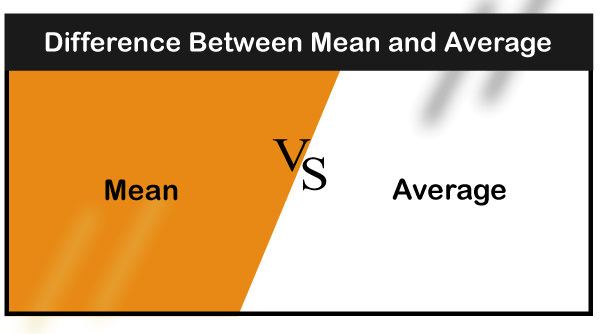Difference between Mean and Average
“Mean” and “Average” are quite the same in mathematics, but there is a slight difference in formula. If you want to understand the basic difference between Mean and Average, you need to know what separates one from another. Mean and Average look similar to each other but in Statistics, in place of the term “Average,” the term “Mean” is used. The term “Mean” refers to the addition of the largest and smallest values in the set of numbers and dividing them by two, whereas the term “Average” refers to the sum of all the numbers divided by the total number of values in the set. Read on the given tutorial to know the difference between Mean and Average.
What is mean?
In mathematics, there are various types of Mean.
- Arithmetic mean
- Geometric mean
- Harmonic mean
Arithmetic mean:
The arithmetic mean is calculated for those set of values which have more difference or they are not at all close to each other. Some of the values in the set can be close to each other, but most given values have a large difference between them.
How to calculate the arithmetic mean?
Follow the following steps to calculate the arithmetic mean.
Add up all numbers in the set of the given numbers to find the overall sum. For example, if you want to find the overall total of the given set of numbers: 6, 5, 9, and 4. The sum would be equivalent to 24.
In the next step, you need to divide the overall sum by how many numbers are given in the set. As seen for the example given in the previous step, we know the total of the set of numbers was equivalent to 24. Now, in this step, you need to divide that total by the total numbers are given in the set. For example, we know there are four numbers given in the set. Therefore, 24 divided by 4, we know, is equal to 6. This would be considered the arithmetic mean.
Geometric mean
The geometric mean refers to the average of a data set, the calculation of which is commonly used to determine the performance results of any business organization. In mathematics, it is defined as “the nth root of n numbers.”
An arithmetic mean of two numbers is the number when added to itself equals the sum of the two numbers. A geometric mean is the number, when multiplied by itself, is equal to the product of the two numbers.
The geometric mean of 5 and 5 is 5 because the √5*5 = 5.
If you have three numbers, and if you want to find the geometric mean take the cube root of the product of all three numbers.
If you need the geometric mean of n numbers, take the nth root of the product of all n numbers.
Harmonic mean
The harmonic mean is useful for calculating the average of rates of things (like velocity, which is the rate at which displacement changes over time, and in finance, the price-earnings ratio, which is the ratio of costs to profits). It finds the inverse of each value, calculates the arithmetic mean, then finds the inverse again.
For example, if peter can finish work in 4 hours and Musk can finish the same work in 3 hours, how long would it take to finish the work if they work together.
Peter takes 4 hours, and Musk takes 3 hours, so the rate of doing work peter is ¼ whereas the rate of doing work of bob is 1/3. Together they work at the rate of 1/3 + ¼ = 7/12. Therefore, they take 12/7 hrs.
What is Average?
In mathematics, an average refers to a series of data in the expression of the middle value of the data set. In other words, an average is defined as the ratio of summation of all the terms (a set of numbers that is found by adding all the numbers in the set) to the number of terms present in the data set.
For example, the average of 7,4,6,3 and 5 is
Sum of all the terms = 7+4+6+3+5 = 25
Number of terms = 5
Therefore, Average = 25/5 = 5, so here 5 is the central value of 7,4,6,3, and 5.
Average = Sum of all terms/Number of terms.
The formula of average has many applications which play a vital role in day-to-day life. Let us consider an example of average, suppose, if we have to find the average age of men and women in a college, we need to calculate it by just adding all the age and dividing it by the number of men and women.
Difference between Mean and Average

| Mean | Average |
|---|---|
| The term “Mean” refers to the addition of the largest and smallest values in the set of numbers and dividing them by 2 | The term “Average” is defined as the ratio of summation of all the terms (a set of numbers that is found by adding all the numbers in the set) to the number of terms present in the data set. |
| There are three different kinds of Mean; Arithmetic mean, Geometric mean, and Harmonic mean. | Average refers to the arithmetic mean. |
| Mean refers to the middle point of the number sets. | An “Average” refers to an individual number taken as representative of a number set. |
| Mean is specifically used in mathematics (DI and Statistics) | Average is generally used in general English conversation. |
| It is primarily used in Statistics, and it is applied for Binomial, geometric distribution. | The average is calculated for any discrete number system where it takes a uniform distribution. |
| Mean is denoted by µ. | The average is denoted by the X bar. |
